

Search london history from Roman times to modern day
This London history site is a wiki of early London streets.
That it was _countrified_ about this part of London, is shown by the accompanying Copy of an engraving, by J. T. Smith, of a view "near Battle Bridge."[18]
The etymology of Battle Bridge, which consists of only one arch, and now forms a part of the Fleet Sewer, is a much vexed question. At one time it was an article of faith, not to be impugned, that here, A.D. 61, was fought the famous battle between the Romans, under Suetonius Paulinus, and the Britons, under Boadicea, Queen of the Iceni, which ended so disastrously for the natives--eighty thousand of whom are said to have been killed. But there seems to be a doubt, as to whether this was the exact spot where this historical contest took place, for Tacitus makes no mention of the little river Fleet, which must then have been navigable for light and small craft, for an anchor was found, in its bed, at Kentish Town. He only describes it (Tacit. Ann. lib. xiv. c. 34) a spot of ground, "narrow at the entrance, and sheltered in the rear by a thick forest." No remains have ever been exhumed, nor have Roman, or British, relics been found near the spot.
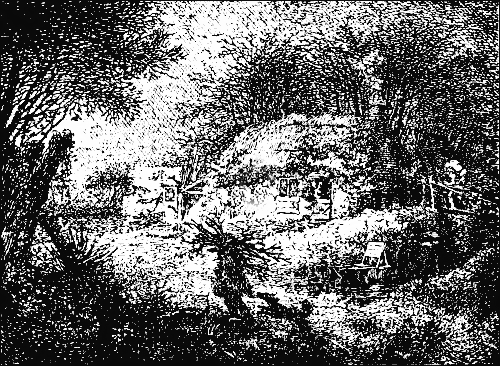
[Illustration: BATTLE BRIDGE.]
In the first quarter of this century the Fleet, for the greater part of its time, ran placidly along, as we see by these two pen-and-ink sketches, taken at Battle Bridge.[19] But, occasionally, it forgot its good manners, and overflowed its banks, flooding portions of Kentish Town, Somers Town, and Battle Bridge, as we read in the _Gentlemans Magazine_, vol. lxxxviii. part i. p. 462, Saturday, May 9, 1818:--
"From the heavy rain, which commenced yesterday afternoon at six o'clock, and continued pouring incessantly till four this morning, Battle Bridge, St. Pancras, and part of Somers Town were inundated. The water was several feet deep in many of the houses, and covered an extent of upwards of a mile. The carcases of several sheep and goats were found near Hampstead Reservoir, and property was damaged to a very considerable amount."
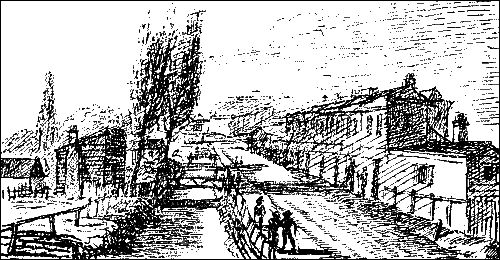
[Illustration: BATTLE BRIDGE.]
There must have been a Mill here, for Stow tells us that in the reign of Edward VI. "A Miller of Battaile Bridge was set on the Pillory in Cheape, and had both his eares cut off, for seditious words by him spoken against the Duke of Somerset."
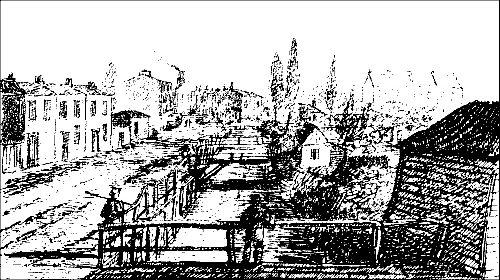
[Illustration: BATTLE BRIDGE.]
Here, as elsewhere, just outside London, the road was not too safe for travellers, as the following account of a highway robbery will show. It was committed by one John Everett, whose career in life had been rather chequered. As an apprentice he ran away, and enlisted in Flanders, rising to the rank of sergeant. When the troops returned, he purchased his discharge, and got a situation in the Whitechapel Debtors' Court, but had to leave it, and he became a companion of thieves, against whom he turned king's evidence. He got into debt, and was locked up in the Fleet Prison, but was allowed to reside within the Rules, a district round about the prison, out of which no prisoner might wander; and there, in the Old Bailey, he kept a public-house. But he could not keep away from evil doing, and was sent to Newgate. On the expiration of his sentence, he turned highwayman. In the course of his professional career he, on December 24, 1730, stopped a Coach at Battle Bridge, which coach contained two ladies, a child, and a maidservant, and he despoiled them, but not uncivilly. The husband of one of the ladies coming up, pursued him, and next day he was caught. It was not then, any more than it is now, that every rogue got his deserts, but this one did, for he was hanged at Tyburn, February 20, 1731.
The name of "Battle Bridge" is well-nigh forgotten, and "King's Cross" reigns in its stead. Yet how few Londoners of the present generation know whence the name is derived! If they ever trouble their heads about it at all, they probably imagine that it was a cross, like the Eleanor Crosses, raised to the memory of some king.
And what king, think you, was it intended to keep in perpetual remembrance? None other than his Most Gracious Majesty King George the Fourth, of pious memory. Why this monument was raised I have never been able to learn, unless it was to celebrate his death, which took place in 1830, and probably to hold up his many virtues, as bright exemplars, to ages yet unborn; but a mad fit came over the inhabitants of Battle Bridge, and the hideous structure arose. It was all shoddy; in the form of an octagon building ornamented with pilasters, all substantially built of brick, and covered over with compo or cement, in order to render it more enduring. It was used as a police-station, and afterwards as a public-house, whilst the pediment of the statue was utilized as a camera obscura. I don't think they knew exactly what they were about, for one party wanted it to be called Boadicea's Cross, another went in for it being nationally named St. George's Cross; but the goodness of the late king was more popular, and carried the day, and we now enjoy the _nominis umbra_ of King's Cross, instead of the old cognomen of Battle Bridge. It had a very brief existence. It was built between 1830 and 1835, and was demolished in 1845; the stucco statue only having been _in situ_ for ten years. It is said that the nose of this regal statue had, for its base, an earthen draining tile, and that it was offered to a gentleman for sixpence!
There hardly seems to be any connection between "the first gentleman in Europe" and dustmen, but there is a slight link. Battle Bridge was peculiarly the home of the necessary dustman, and in a song called "The Literary Dustman," commencing--
"They call me Adam Bell, 'tis clear That Adam vos the fust man, And by a co-in-side-ance queer Vy I'm the fust of dustmen,"
is the following verse:--
"Great sculptors all conwarse wi' me, And call my taste divine, sirs, King George's statty at King's Cross, Vos built from my design, sirs."
Close by here, in Gray's Inn Road, was a mountain of refuse and dust; but it was as profitable as were the heaps of Mr. Boffin in Charles Dickens's "Our Mutual Friend." This mound once had a curious clearance, so it is said. It was bought in its entirety, and sent over to Russia, to help make bricks to rebuild Moscow; and the ground on which it stood was, in 1826, sold to a Company for L15,000.
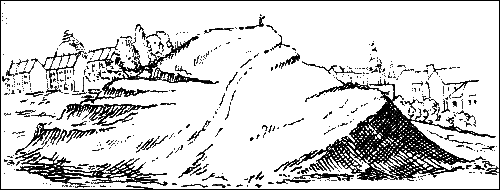
[Illustration: DUST HEAP AT BATTLE BRIDGE.]
"My dawning Genus fust did peep, Near Battle Bridge,'tis plain, sirs: You recollect the cinder heap, Vot stood in Gray's Inn Lane, sirs?"
* * * * *
Let us turn to a sweeter subject, and gossip about St. Chad's Well, the site of which is now occupied by the Metropolitan Railway at King's Cross. St. Chad is a saint in the English calendar, and might have been a distinguished temperance leader, if the number of wells dedicated to him, is any criterion. He lived in the seventh century, and was educated at Lindisfarne (at least so Bede says), and afterwards became Bishop of Lichfield, and, at his death, his soul is said to have been accompanied to heaven by angels and sweet music.
A good modern account is given in Hone's "Every Day Book," vol. i. pp. 323, 4, 5, which, as it was taken from actual observation about fifty years since, may well be transcribed. Speaking of the aforesaid dust-heap he says:--
"Opposite to this unsightly site, and on the right hand side of the road, is an anglewise faded inscription--
"It stands, or rather dejects, over an elderly pair of wooden gates, one whereof opens on a scene which the unaccustomed eye may take for the pleasure-ground of Giant Despair. Trees stand as if made not to vegetate, clipped hedges seem unwilling to decline, and nameless weeds straggle weakly upon unlimited borders. If you look upwards you perceive, painted on an octagon board, 'Health restored and preserved.' Further on, towards the left, stands a low, old-fashioned, comfortable-looking, large-windowed dwelling, and, ten to one, but there also stands at the open door, an ancient ailing female, in a black bonnet, a clean, coloured cotton gown, and a check apron, her silver hair only in part tucked beneath the narrow border of a frilled cap, with a sedate and patient, yet somewhat inquiring look. She gratuitously tells you that 'the gardens' of 'St. Chad's Well' are for 'Circulation' by paying for the waters, of which you may drink as much, or as little, or nothing, as you please, at one guinea per year, 9s. 6d. quarterly, 4s. 6d. monthly, or 1s. 6d. weekly. You qualify for a single visit by paying sixpence, and a large glass tumbler, full of warm water, is handed to you. As a stranger, you are told, that 'St. Chad's Well was famous at one time.'
"Should you be inquisitive, the dame will instruct you, with an earnest eye, that 'people are not what they were,' 'things are not as they used to be,' and she 'can't tell what'll happen next.' Oracles have not ceased. While drinking St. Chad's water, you observe an immense copper, into which it is poured, wherein it is heated to due efficacy, and from whence it is drawn by a cock, into glasses. You also remark, hanging on the wall, a 'tribute of gratitude,' versified, and inscribed on vellum, beneath a pane of glass stained by the hand of time, and let into a black frame. This is an effusion for value received from St. Chad's invaluable water. But, above all, there is a full-sized portrait in oil, of a stout, comely personage, with a ruddy countenance, in a coat or cloak, supposed scarlet, a laced cravat falling down the breast, and a small red nightcap carelessly placed on the head, conveying the idea that it was painted for the likeness of some opulent butcher, who flourished in the reign of Queen Anne. Ask the dame about it, and she refers you to 'Rhone.'[20] This is a tall old man, who would be taller if he were not bent by years. 'I am ninety-four,' he will tell you, 'this present year of our Lord, one thousand, eight hundred, and twenty-five.' All that he has to communicate concerning the portrait is, 'I have heard say it is the portrait of St. Chad.' Should you venture to differ, he adds, 'this is the opinion of most people who come here.' You may gather that it is his own undoubted belief.
"On pacing the garden alleys, and peeping at the places of retirement, you imagine the whole may have been improved and beautified, for the last time, by some countryman of William III., who came over and died in the same year with that king, and whose works here, in wood and box, have been following him piecemeal ever since.
"St. Chad's Well is scarcely known in the neighbourhood save by its sign-board of invitation and forbidding externals;... it is haunted, not frequented. A few years, and it will be with its waters, as with the water of St. Pancras' Well, which is enclosed in the garden of a private house, near old St. Pancras Churchyard."
But, although the prophecy in "Hone" was destined to be fulfilled, yet it was twelve years before it came about, and it was not until September 14, 1837, that Messrs. Warlters and Co. sold, at Garraway's Coffee House, Change Alley, Cornhill, the "valuable Copyhold Property, situate in Gray's Inn Lane, near King's Cross, Battle Bridge," which consisted of "The well-known and valuable Premises, Dwelling-house, Large Garden, and Offices, with the very celebrated Spring of Saline Water called St. Chad's Well, which, in proper hands, would produce an inexhaustible Revenue, as its qualities are allowed by the first Physicians to be unequalled."
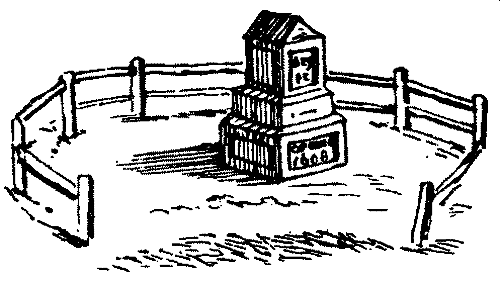
[Illustration: ST. CHAD'S WELL.]
It was a good sized piece of ground; in shape of a somewhat irregular triangle, of which the base measured about 200 feet, and from apex to base 95 feet. It was Copyhold. The vendor was not to be asked for a title prior to 1793, and it was held of the Manor of _Cantlowes_ or _Cantlers_, subject to a small fine, certain, of 6s. 8d., on death or alienation, and to a Quit Rent of 5d. per annum. We should say, nowadays, that the assessment was very small, as, including the large gardens, both back and front, the whole was only valued, including the _Saline Spring_, at L81 10s. per annum, of which L21 10s. was let off, but which formed but a small portion of the property.
What would not the waters of St. Chad's Well cure? Really I think the proprietor hardly knew himself, for a handbill I have before me commences--"The celebrity of these waters being confined chiefly to its own immediate vicinity for a number of years; the present proprietor has thought proper to give more extensive publicity to the existence of a nostrum provided by Nature, through Divine Providence, approaching nearest that great desideratum of scientific men and mankind in general, throughout all ages; namely, an UNIVERSAL MEDICINE.... The many cures yearly performed by these waters does not come within the limits of a handbill, but, suffice it to say, that here, upon trial, the sufferer finds a speedy and sure relief from INDIGESTION and its train, HABITUAL COSTIVENESS, the extensive range of LIVER COMPLAINTS, DROPSY in its early stages, GLANDULAR OBSTRUCTIONS, and that bane of life, SCROPHULA; for ERUPTIONS ON THE FACE OR SKIN its almost immediate efficacy needs but a trial." This wonderful water, with use of garden, was then, say 1835, supposed to be worth to the sufferer L1 per annum, or threepence a visit, or you might have it supplied at eightpence per gallon.
And yet it seems only to have been a mild aperient, and rather dear at the price. In the _Mirror_ of April 13, 1833, Mr. Booth, Professor of Chemistry, professed to give an analysis of the "Mineral Waters in the neighbourhood of London," and he thus writes of St. Chad's Well: "It is aperient, and is yet much resorted to by the poorer classes of the metropolis, with whom it enjoys considerable reputation. From an examination, I find it to be a strong solution of sulphate of soda and sulphate of magnesia"--but he does not favour us with a quantitative analysis.
Neither does the proprietor, one Wm. Lucas, who not only propounded the handbill from which I have quoted, but published a pamphlet on the healing virtues of the spring, and he also adds to Mr. Booth's qualitative analysis, "a small quantity of Iron, which is held in Solution by Carbonic Acid."
"The Well from which the Waters are supplied, is excluded from the external air; the Water when freshly drawn is perfectly clear and pellucid, and sparkles when poured into a glass; to the taste it is slightly bitter, not sufficiently so to render it disagreeable; indeed, Persons often think it so palatable as to take it at the table for a common beverage."
This, however, is slightly at variance with the following, "As a Purgative, more so than could be inferred from their taste, a pint is the ordinary dose for an Adult, which operates pleasantly, powerfully, and speedily:" qualities which are scarcely desirable for a Table water.
That, at one time, this Well was in fashion, although in 1825 it was in its decadence, I may quote from the pamphlet (which, however, must be taken by the reader, _quantum valeat_):
"JONATHAN RHONE, who was Gardener and Waiter at these Wells upwards of Sixty Years, says, that when he first came into office at about the middle of the eighteenth Century, the Waters were in great repute, and frequently were visited by eight or nine hundred Persons in a morning: the charge for drinking the Waters was Three pence each Person, and they were delivered at the Pump Room for exportation, at the rate of Twenty-four pint bottles, packed in hamper, for One Pound Cash."
[Footnote 18: See next page.]
[Footnote 19: See pages 41, 42.]
[Footnote 20: Rhone was an old waiter at the Well. See p. 51.]
[Illustration]
Trying to avoid privacy and cookie settings overwriting content